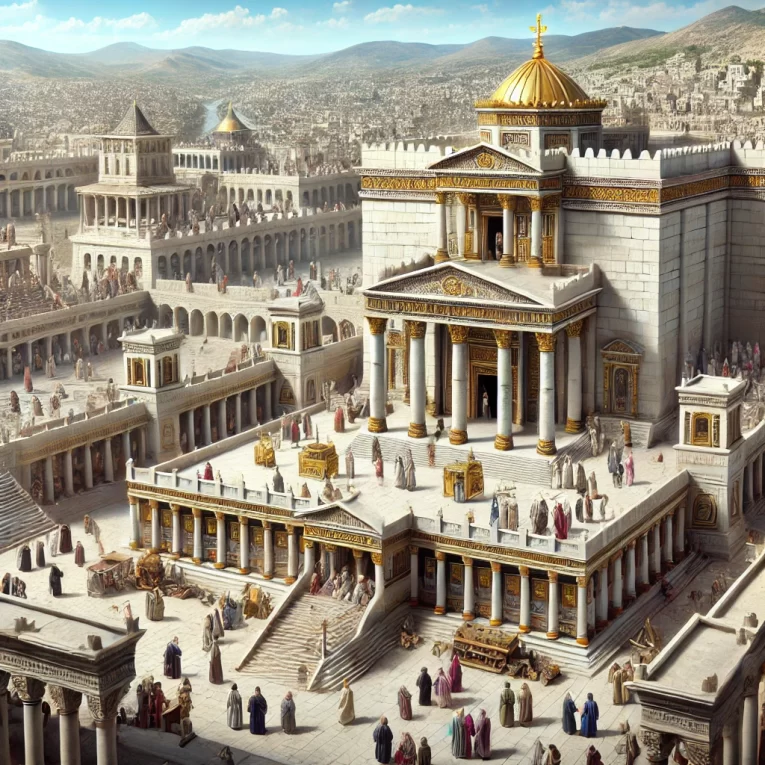
Subject: Jesus Cleanses the Temple and Reveals His Authority
Opening Prayer
Heavenly Father, we thank You for the opportunity to gather and study Your Word. As we reflect on Jesus’ actions in the temple and His declaration of authority, may Your Spirit guide us to understand and apply these truths. Help us to approach You with reverence and live lives that honor Your name. In Jesus’ name, Amen.
Summary and Key Theme
Book Summary: The Gospel of John reveals Jesus as the Word of God made flesh, focusing on His divinity, signs, and teachings. John calls readers to believe in Jesus as the Messiah and Son of God for eternal life (John 20:31).
Chapter Summary: In John 2:13–25, Jesus goes to Jerusalem for the Passover and finds the temple being misused for commerce. He drives out the merchants and money changers, asserting His authority as the Son of God. When questioned by the Jewish leaders, Jesus speaks of His resurrection as the ultimate sign of His authority. The chapter concludes with a note about superficial belief, as Jesus discerns the true intentions of human hearts. Key Theme: Jesus demonstrates His authority over worship and foretells His resurrection as the foundation of true faith.
Scripture Breakdown & Key Points
1. The Passover and the Temple’s Condition (John 2:13–14, NIV)
13 When it was almost time for the Jewish Passover, Jesus went up to Jerusalem. 14 In the temple courts he found people selling cattle, sheep and doves, and others sitting at tables exchanging money.
- Jesus arrives in Jerusalem for the Passover, a sacred time for worship and sacrifice.
- He finds the temple courts turned into a marketplace, dishonoring its purpose.
- Commentary: The temple, intended as a place of worship, had become a marketplace. Merchants exploited worshippers, overshadowing the sacred purpose of Passover.
- Cultural Insight: Passover was a pilgrimage feast, and travelers often purchased sacrificial animals upon arrival, leading to opportunistic commerce.
2. Jesus Cleanses the Temple (John 2:15–17, NIV)
15 So he made a whip out of cords, and drove all from the temple courts, both sheep and cattle; he scattered the coins of the money changers and overturned their tables. 16 To those who sold doves he said, “Get these out of here! Stop turning my Father’s house into a market!” 17 His disciples remembered that it is written: “Zeal for your house will consume me.”
- Jesus drives out the merchants, overturns tables, and declares the temple as His Father’s house.
- His actions reveal His zeal for God’s holiness, fulfilling Psalm 69:9.
- Commentary: Jesus demonstrates righteous anger, defending the sanctity of worship. His actions fulfill the prophecy of Psalm 69:9, highlighting His zeal for God’s glory.
- Historical Insight: The temple during Jesus’ time had become a center of economic exploitation, particularly during Passover, with the high priesthood profiting from inflated fees for sacrifices and currency exchanges, which corrupted its intended sanctity.
3. The Jewish Leaders Demand a Sign (John 2:18–19, NIV)
18 The Jews then responded to him, “What sign can you show us to prove your authority to do all this?” 19 Jesus answered them, “Destroy this temple, and I will raise it again in three days.”
- The Jewish leaders demand a sign to prove Jesus’ authority to cleanse the temple.
- Jesus responds by speaking of His resurrection, using the temple as a metaphor for His body.
- Commentary: The Jewish leaders demand proof of Jesus’ authority, reflecting their focus on outward validation. Jesus refers to His resurrection, which will authenticate His divine mission.
- Greek Insight: The word “destroy” (λύω, lyō, Strong’s G3089) implies dismantling, symbolizing the end of the old covenant.
4. Misunderstanding Jesus’ Words (John 2:20–22, NIV)
20 They replied, “It has taken forty-six years to build this temple, and you are going to raise it in three days?” 21 But the temple he had spoken of was his body. 22 After he was raised from the dead, his disciples recalled what he had said. Then they believed the scripture and the words that Jesus had spoken.
- The Jews misunderstand Jesus, focusing on the physical temple’s construction.
- After His resurrection, His disciples recall this moment and believe in His words.
- Commentary: The Jews interpret Jesus’ words literally, missing the spiritual truth. His resurrection becomes the fulfillment of His prophecy, strengthening His disciples’ faith.
- Archeological Insight: Archaeological excavations around the Temple Mount have uncovered remnants of Herod’s Temple, including massive foundation stones and inscriptions, confirming the grandeur of the structure and providing context for the physical and cultural importance of the temple in Jesus’ time.
5. Superficial Belief (John 2:23–25, NIV)
23 Now while he was in Jerusalem at the Passover Festival, many people saw the signs he was performing and believed in his name. 24 But Jesus would not entrust himself to them, for he knew all people. 25 He did not need any testimony about mankind, for he knew what was in each person.
- Many believe in Jesus because of His signs, but Jesus does not entrust Himself to them.
- Commentary: While many were impressed by Jesus’ signs, their faith was superficial. Jesus discerned their true intentions, emphasizing the need for genuine belief.
- Key Point: Jesus’ ability to discern superficial belief highlights His divine knowledge of human hearts, emphasizing that true faith must go beyond signs and miracles to a deep, personal trust in Him.
Practical Application
- Righteous Anger and Reverence: Jesus’ cleansing of the temple shows His righteous anger toward those dishonoring God’s house. This challenges us to examine our own lives and remove anything that disrespects God’s holiness or hinders our worship.
- Zeal for Worship: Jesus was consumed by zeal for God’s house (John 2:17). This inspires us to develop a passionate commitment to honoring God in our worship and making Him the center of our lives.
- Faith in God’s Promises: Jesus’ statement about raising the temple in three days (John 2:19) points to His resurrection. We are reminded to trust in God’s promises, even when they seem unclear or beyond our understanding.
- Removing Distractions: The merchants in the temple distracted worshipers from their true purpose. This encourages us to identify and eliminate distractions in our own lives that pull us away from focusing on God.
- Living as a Temple of the Holy Spirit: Jesus redefines the temple as His body, and through Him, believers become temples of the Holy Spirit. This calls us to live with purity, integrity, and a focus on glorifying God in every aspect of our lives.
- Top of Form
Parallel Bible References
- Solomon’s Dedication of the Temple (1 Kings 8:10–11, NIV): The temple was filled with God’s presence, emphasizing its sacredness, which Jesus defends in this passage.
- Prophecy of a New Covenant (Jeremiah 31:31–34, NIV): Jesus’ resurrection fulfills the promise of a new covenant, making Him the true temple.
- Psalm 69:9 (NIV): Connection: This prophecy about zeal for God’s house directly connects to Jesus’ actions in John 2:17.
- The Samaritan Woman and Worship (John 4:23–24, NIV): Connection: Jesus emphasizes worship in spirit and truth, foreshadowing the end of temple-centered worship.
- The Veil Torn at Jesus’ Death (Matthew 27:51, NIV): Connection: The tearing of the temple veil signifies direct access to God through Jesus.
Group Discussion Questions
- How does Jesus’ cleansing of the temple challenge us to honor God in our worship?
- Example: 1 Corinthians 6:19–20 reminds us that our bodies are temples of the Holy Spirit.
- What does Jesus’ response to the Jewish leaders teach us about trusting His authority?
- Example: Proverbs 3:5–6 calls us to trust in the Lord rather than lean on our own understanding.
- How can we cultivate genuine faith rather than superficial belief?
- Example: James 2:17 emphasizes that faith without deeds is dead.
Weekly Challenge
Examine one area of your life where distractions have hindered your relationship with God. Take steps this week to remove those distractions and dedicate that time to worship and prayer.
Closing Prayer
Father, thank You for the truths we’ve learned today. Help us to honor You in our worship, trust in Your authority, and grow in genuine faith. Empower us to live out these lessons for Your glory. In Jesus’ name, Amen.
Personal Homework
- Memorize John 2:19 and reflect on how it strengthens your faith.
- Read and meditate on Psalm 69, considering how Jesus fulfills its prophecy.
- Write a one-page reflection on how Jesus’ authority impacts your daily decisions.
Jewish Passover & The Seder Meal
- The Passover – https://www.jewishvirtuallibrary.org/passover-history-and-overview
- Seder Plate Items & Meanings
Each item on the Seder plate holds symbolic significance related to the story of the Exodus:- Maror (Bitter Herbs): Often horseradish or romaine lettuce, symbolizing the bitterness of slavery.
- Charoset: A sweet mixture of apples, nuts, wine, and spices, representing the mortar used by Hebrew slaves in Egypt.
- Karpas (Vegetable): Typically parsley or celery, dipped in salt water to symbolize the tears shed in slavery.
- Z’roa (Shank Bone): A roasted lamb or chicken bone symbolizing the Passover sacrifice.
- Beitzah (Roasted Egg): Symbolizing mourning and the cycle of life; also represents a festival offering in the temple.
- Chazeret (Second Bitter Herb): Often lettuce, used during the korech (Hillel sandwich) portion of the Seder.
- Matzah (Unleavened Bread)
- Three pieces of matzah are placed on the table, representing the bread of affliction the Israelites ate when fleeing Egypt.
- Salt Water
- Used for dipping the karpas, symbolizing the tears of the enslaved Israelites.
- Four Cups of Wine (or Grape Juice)
- Representing the four expressions of redemption in Exodus 6:6–7. Each cup is drunk at specific points during the Seder.
- Afikoman
- A piece of matzah broken and hidden during the Seder, symbolizing the Passover sacrifice.
- Cup for Elijah
- A symbolic fifth cup of wine placed on the table, representing the future arrival of Elijah and the Messianic age.
- Meal Courses
While the specific dishes vary by tradition, the meal typically includes:- Soup: Often matzah ball soup.
- Meat or Fish Dishes: Reflecting festive celebration.
- Side Dishes: Often include potatoes, vegetables, and Passover-compliant kugel (a baked dish).
- Desserts: Made without leavening, such as fruit, macaroons, or Passover cake.
Additional Resources
- NIV Study Bible – Provides detailed notes and theological insights.
- Matthew Henry’s Commentary – Offers a classic, in-depth perspective on Scripture.
- BibleGateway.com – A helpful tool for cross-referencing and word studies.
- BlueLetterBible.org – Includes Greek and Hebrew tools with Strong’s numbers.
- “The Gospel According to John” by Leon Morris – A thorough theological study of John’s Gospel.

